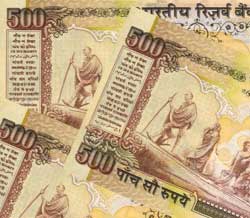Indian Currency Slips From All-Time Highs, RBI Hand Seen
 Mumbai: The rupee dropped off from nine-and-a-half year peaks on yesterday, driven lower by suspected central bank interference and some short covering by capitalists, even if flows into the stock exchange limited losses.
Mumbai: The rupee dropped off from nine-and-a-half year peaks on yesterday, driven lower by suspected central bank interference and some short covering by capitalists, even if flows into the stock exchange limited losses.
The partially convertible rupee ended at 39.8450/8500 per dollar, dislocating from its last day close of 39.71/72, when it hit a high of 39.62 in early trade its most accented since April 1998.
A senior dealer with a private bank said, “The central bank was buying dollars intermittently but came in strong for the last five minutes and pushed the rupee lower.”
Benchmark share index ascended to an all-time high for the eighth straight session on Friday, with global investors drawn by attractive returns offered by local stocks.
A few traders covered short positions, expecting a small alteration in the stock exchange, and the resulting capital outflows.
Data illustrates that foreign investors have pumped-up about $2.2 billion into Indian share markets in the six days after last Tuesday’s rate cut by the Federal Reserve.
Capital inflows into local securities have assisted the rupee appreciate over 11 per cent this year, to be Asia's best performing currency as compared to the dollar.
The rupee’s speedy rise has urged the RBI to intervene against it, and the market broadly thinks the central bank will make a combined attempt to check the rupee does not apprize past 39.60 in the coming days.
The data showed that the RBI has purchased $38.1 billion in an offer to stem the currency’s increase in the first seven months of the existing fiscal.
Still, JPMorgan advanced their viewpoint for the Indian currency to 39.50 by end-2007 on Friday, as weakness in the U.S. currency worldwide would relieve stress on the RBI to stop the local unit from climbing up.